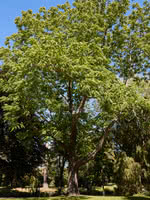Mon-Fri 9am - 5pm Mountain time
Black Walnut vs Prairie Skyrise Aspen
Juglans nigra
Populus tremuloides Prairie Skyrise
NOT AVAILABLE THIS SEASON - MIGHT RETURN
CUSTOM GROW
The Black Walnut is a slow growing, large, straight-stemmed tree with an open crown. It produces dense, very hard, edible nuts.
Black Walnut has a deeply-furrowed, black bark. Its leaves are about 1 foot long, composed of 15 - 23 slightly stalked leaflets on a moderately stout stock which provide good dappled shade.
Despite being highly valued for its edible nuts and its shade tree aesthetics, it is rare to see this tree on the prairies.
Note: Black Walnut's roots produce a substance named juglone that is toxic to some other plants. Consider this when choosing where you plant a black walnut, as you will not be able to grow tomato, potato, cabbage, eggplant, blueberry, azalea, rhododendron, lilac, red pine and apple in the surrounding area.
Note: Plant this tree once. It will not respond well to transplanting.
Note: Although self-pollinating, planting two trees significantly improves nut production.
A top CO2 absorbing species. Experts think this tree may help climate change more than others.
Prairie Skyrise Aspen has a compact and columnar branching structure that makes it a great privacy screen for small yards. You'll notice that the old and new growth have contrasting colors of green, giving this tree an attractive and unique appearance.
Prairie Skyrise Aspen is more disease resistant, columnar, and typically leafs out earlier than Swedish Aspen.

